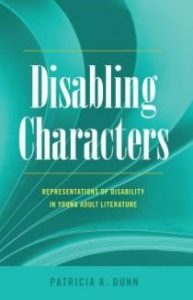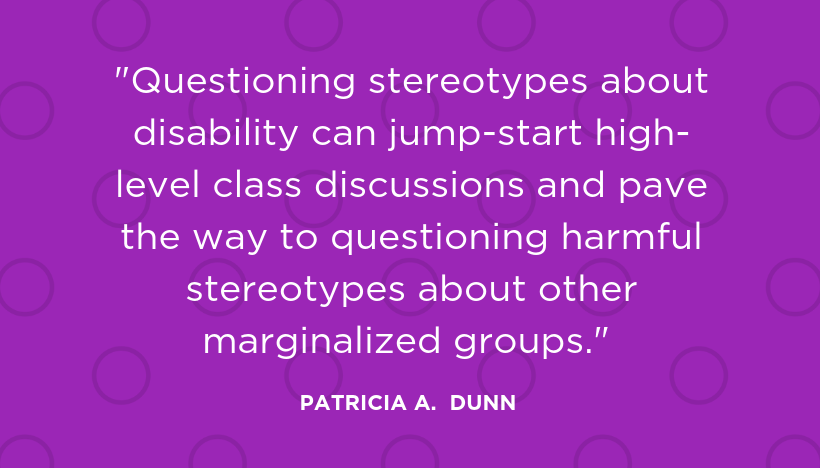This post is written by NCTE member Patricia Dunn.
 Whether students are disabled or nondisabled themselves, they absorb impressions about characters like or unlike themselves from the books they read for school. So when they read books that feature characters with disabilities, what messages are they getting about disability? Does the story reinforce negative stereotypes (that disabled people are pitiable, helpless, evil, super human, magically cured at the end, or dead)? Or does the text challenge negative stereotypes in its depiction of characters with impairments by showing that they are complex individuals, that they enjoy their lives and are as “normal” as nondisabled people, and that they have agency and voice?
Whether students are disabled or nondisabled themselves, they absorb impressions about characters like or unlike themselves from the books they read for school. So when they read books that feature characters with disabilities, what messages are they getting about disability? Does the story reinforce negative stereotypes (that disabled people are pitiable, helpless, evil, super human, magically cured at the end, or dead)? Or does the text challenge negative stereotypes in its depiction of characters with impairments by showing that they are complex individuals, that they enjoy their lives and are as “normal” as nondisabled people, and that they have agency and voice?
Classic Texts and Disability: Read, But Heed
Disabled characters are everywhere in canonical texts: Tom Robinson (and probably Boo Radley) in To Kill a Mockingbird; Lenny in Of Mice and Men; Laura in The Glass Menagerie; Tiresias in Oedipus; Doodle in the widely anthologized short story, “The Scarlet Ibis,” and so on. Classic texts will continue to be part of the curriculum for a long time to come, as well some of them should be. But teachers can take heed of how characters with disabilities are represented. We can then supplement the usual questions about theme, literary elements, or plot lines with critical questions about what the text seems to imply about characters (and real people) with disabilities.
Contemporary YA Literature: Explore, But Do More
In recent years, many more disability-themed YA novels have been published. Some, thankfully, actively work against old stereotypes. Works such Johnson’s Accidents of Nature, Orr’s Peeling the Onion, and Alexie’s True Diary, written by authors with disabilities similar to those of their protagonists, depict these characters as fully developed individuals with agency, voice, and a critical attitude toward their ableist societies. (See The Schneider Family Book Award website for lists of books with the most potential to disrupt harmful depictions.) Other new novels, however, continue to rely on old stereotypes. Some do a bit of both and cannot be put squarely into a thumbs-up or thumbs-down category. There are many such new novels to explore. However, teachers need to do more: we need to make sure that students reading recent disability-themed YA novels do not come away from those texts without questioning lingering stereotypes that might be woven into the novel’s assumptions.
Question Stereotypes

One way to disrupt harmful stereotypes is to supplement the usual discussion questions about literary elements, themes, and plot lines with more pointed questions to get students thinking and rejecting tired depictions. Here are some questions from my recent book, Disabling Characters: Representations of Disability in Young Adult Literature (a digital version with a sample is available at iTunes):
- How is disability represented in this text?
- What happens to the character with the disability at the end? What do you think of that ending? What message does it seem to deliver, in an unspoken way, about disability?
- What are some implications of those representations for individuals in the real world?
Other questions might examine the extent to which exclusionary practices in society contribute to—indeed, disable the individual—more than does that person’s impairment. Paired readings can also be helpful: an older work that has embedded stereotypes can be read alongside a text that challenges those same stereotypes. See, for example, the excellent text-pairing suggestions made by Dynelle Fields, Kelly Kim, and Casey Spencer regarding books with stereotypical deaf characters being paired with more authentic depictions. And finally, all students can have a more informed basis for such a discussion by reading reviews of a particular book written by readers with the same disability as the book’s characters (see disabilityinkidlit).
There is much going on these days in the area of young adult novels and disability. I discuss these issues at more length at Dr. Bickmore’s YA Wednesday blog. And if readers would like more information on Disabling Characters, here are some reviews:
- Mark Letcher’s Review in the July 2016 English Journal
- Scott Pallard’s Review of Disabling Charactersin the Summer 2016 issue of Children’s Literature Association Quarterly
- Michael Northen’s review in Wordgathering
- Peggy L. Kaney’s review in the May 2016 Education Review
Questioning stereotypes about disability can jump-start high-level class discussions and pave the way to questioning harmful stereotypes about other marginalized groups. Reading novels that feature strong, fully developed, authentic characters with disabilities is a refreshing experience. Such novels usually reward the reader by also being more lively, more unusual, and more complex across the board.
Patricia A. Dunn is a former high school teacher who now teaches preservice English teachers at Stony Brook University in New York. She has a regular column, Disabling Assumptions, in English Journal.

